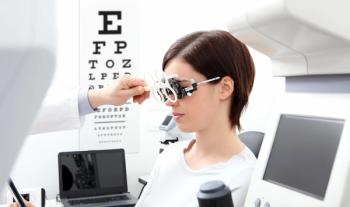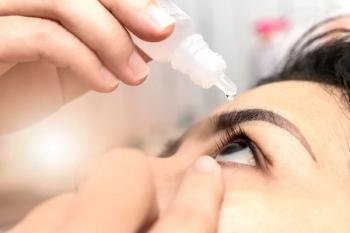
Adverse events linked to OTC cosmetics include inflammation, discomfort, hypersensitivity
Annual reports of the occurrence of adverse effects associated with the use of cosmetics increased from 2006 to 2018, then decreased from 2018 to 2021.
A recent study1 has associated potential ophthalmic adverse events and outcomes with use of over-the-counter (OTC) cosmetics and personal care products, according to first author Aretha Zhu, BS, from the Institute of Ophthalmology and Visual Science, Rutgers New Jersey Medical School, Newark. She was joined in this study by researchers from the Department of Ophthalmology, SUNY Downstate, Brooklyn, New York and the Department of Ophthalmology and Visual Sciences, University of Wisconsin School of Medicine and Public Health, Madison.
The investigators explained that “personal care and cosmetic products can cause periocular and ocular adverse effects, for example, ocular surface disease, trauma, and hypersensitivity.”
They explained that application of cosmetics near the sensitive ocular region can cause harm in various ways. “Cosmetics and applicator tools can cause mechanical trauma to the eye, leading to cornea abrasion.2 Improper hygiene and disposal of products can cause infection.3 The many ingredients in cosmetics and permanent inks, including preservatives, dyes, and fragrances, can also lead to irritation,4 hypersensitivity, inflammatory granulomas, and even sarcoid-type foreign body reactions.3,5,6 Even when externally applied, cosmetics can migrate onto the ocular surface, causing tear film destabilization, tear film hyperosmolarity, and meibomian gland loss.”7-9
These adverse events can be reported to the FDA Center for Food Safety and Applied Nutrition Adverse Event Reporting System (CAERS) database by consumers, healthcare practitioners, and manufacturers.
Zhu and colleagues conducted a study with the goal of characterizing ophthalmic adverse events associated with cosmetics and personal care products that have been reported in the FDA CAERS database.
Adverse effects of OTC products
The researchers found that the annual reports of the occurrence of adverse effects associated with the use of cosmetics increased from 2006 to 2018, reaching the highest number of 161 reports in 2018; this was followed by a decrease in the number of reported effects from 2018 to 2021.
The most reported problematic product categories in descending order were skin products, hair products, miscellaneous products, and eye makeup. The fewest reports involved body care products, permanent makeup, and eyelash makeup.
“In total, 959 and 1,382 unique periocular and ocular adverse events [respectively] were reported. There were 1,711 total incidences of reported periocular adverse effects and 2,485 ocular adverse effects,” they said.
Inflammation, hypersensitivity, and discomfort were the most frequent periocular adverse effects, and discomfort, inflammation, hypersensitivity, and trauma the most reported ocular effects. Regarding ocular involvement, the conjunctiva, eyelid margin, and cornea were the most frequently affected structures.
An especially important finding among many such findings was that when considering the ocular outcomes, hair products was associated with the highest incidence of ocular complications, while permanent products were most associated with periocular complications. The authors found that the hair products, such as topical minoxidil, had the highest incidence of disability and life-threatening outcomes. “We believe this is a plausible finding in line with previous literature that reported the use of hair products resulting in both ocular adverse events and disability."10
The authors emphasized that “consumers, healthcare practitioners, and manufacturers should be made aware of potential ophthalmic adverse events and outcomes associated with cosmetics and personal care products.”
References
Zhu A, Aftab O, Mahajan J, Burkat CN. Ocular adverse effects of over-the-counter cosmetics and personal care products reported to the Food and Drug Administration. Ophthalmic Plast Reconstr Surg. 2025;41:61-66; doi: 10.1097/IOP.0000000000002718
Wilson SE, Bannan RA, McDonald MB, et al. Corneal trauma and infection caused by manipulation of the eyelashes after application of mascara. Cornea. 1990;9:181-181.
Masud M, Moshirfar M, Shah TJ, et al. Eyelid cosmetic enhancements and their associated ocular adverse effects. Med Hypothesis Discov Inov Ophthalmol. 2019;8:96-103.
Verma RP, Matthews EJ. Estimation of the chemical-induced eye injury using a weight-of-evidence (WoE) battery of 21 artificial neural network (ANN) c-QSAR models (QSAR-21): part 1: irritation potential. Regul Toxicol Pharmacol. 2015;71:318-330.
Yazdani M, Elgstoen KBP, Utheim TP. Eye make-up products and dry eye disease: a mini review. Curr Eye Res. 2022;47:1-11.
Hirai Y, Hamada Y, Sasaki S, et al. Sarcoidosis and sarcoidal foreign body reaction after permanent eye makeup applications: analysis by immunohistochemistry with commercially available antibodies specific to Cutibacterium acnes and Mycobacteria. J Cutan Pathol. 2022;49:651-657.
Wang MT, Craig JP. Investigating the effect of eye cosmetics on the tear film: current insights. Clin Optom (Auckl). 2018;10:33-40.
Ercan ZE. Effect of eyeliner and mascara use on tear film and meibomian glands. Saudi J Ophthalmol. 2022;36:113-116.
Murube J. Ocular cosmetics in modern times. Ocul Surf. 2013;11:60-64.
Venkatesh R, Pereira A, Reddy NG, et al. Retinal artery occlusion as a probably idiosyncratic reaction to topical minoxidil: a case report. J Med Case Rep. 2021;15:493.
Newsletter
Want more insights like this? Subscribe to Optometry Times and get clinical pearls and practice tips delivered straight to your inbox.
















































.png)


